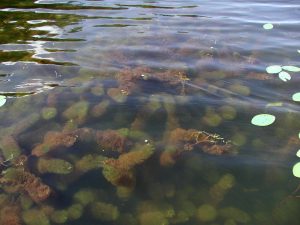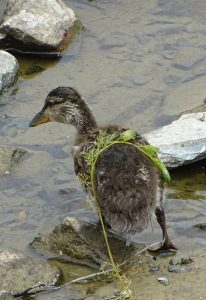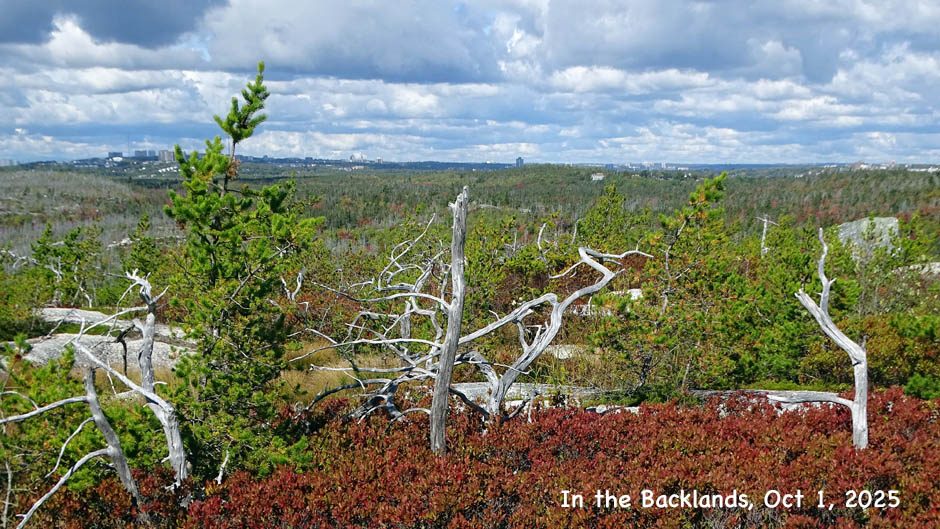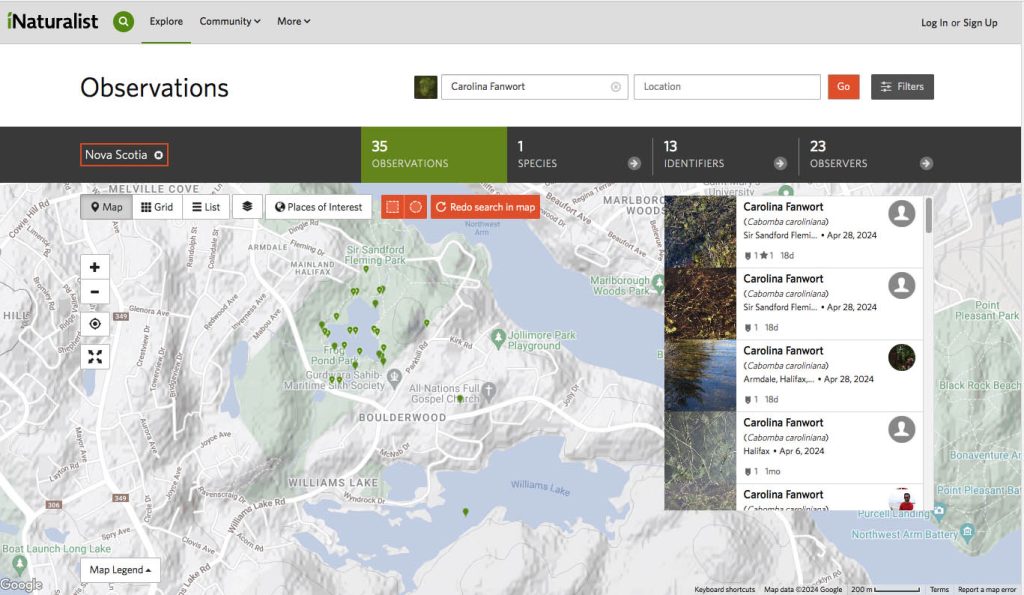
Carolina fanwort – Photo by Leslie J. Mehrhoff, posted on Wikipedia illustrates its green and reddish-brown shoots
UPDATE May 18, 2024: WLCC member Katharine Studholme conducted some follow-up investigation at one patch of new plants in Williams Lake, and is fairly certain it is NOT Carolina Fanwort “and may be a native milfoil.” We are sending identification photos to the NS Wild Flora Society Directors and the NS Museum for confirmation. Regardless, she says “No matter what we find in the rest of the lake, I think we should take preventative action”, citing cleaning of watercraft in particular.

Duck at Frog Pond, Carolina Fanwort on its back (May 17, 2024). More photos on iNaturalist
I collected some plants from Frog Pond yesterday (May 17, 2024), and they appear to be the same species as the specimen from Frog Pond that was identified as Carolina Fanwort in 2017. Conclusion: We are uncertain about whether or not Carolina Fanwort has invaded Williams Lake; regardless there has been an upsurge in aquatics with invasive features, and we need to pay attention to them, also to be on the lookout for Carolina Fanwort.
Also, digging into my archives, I found a report on an earlier observation of Carolina Fanwort in Frog Pond than the first iNaturalist report in 2017; the earlier report was also made by the late Burkhard Plache and his spouse Ingrid in December of 2015. Burkhard comments “I asked for input from the larger naturalist community in Nova Scotia, and Nicolas Hill confirmed that the specimen was indeed a Fanwort. Furthermore, he stated that this would be the first record of Cabomba in the Maritime provinces. Checking with people familiar with Frog Pond provided another piece of information: A fellow naturalist reported seeing but not formally identifying this plant in Frog Pond five years ago, and saw it growing densely in the narrows of Frog Pond this summer (2014).” See An Invasive Aquatic Plant inFrog Pond (Halifax, N.S.), A Report by Burkhard Plache (Halifax Field Naturalists) Jan. 4, 2015
——
ORIGINAL POST (16 May 2024. Original Title: It appears an aggressive invasive aquatic plant – Carolina Fanwort – is now in Williams Lake 16May2024)
At a WLCC Directors meeting yesterday, Leslie Randall initiated a discussion of a new, apparently invasive plant on Williams Lake thought to be Carolina Fanwort (Cabomba caroliniana). Several participants commented that it is “thick on Frog Pond”, and that on Williams Lake, “in places, it so dense that it is difficult to paddle though ” or words to that effect.
So I checked iNaturalist. There are 35 observations for Carolina Fanwort in NS, all in the Halifax area, and there, only on Frog Pond and vicinity (33 observations)
and on Williams Lake and vicinity (1 observation centred on Williams Lake on Apr 6, 2024*; and one nearby on Mar 20, 2022.
*UPDATE May 19, 2024: The Apr 6, 2024 post on iNaturalist indicated a location on Williams lake, however with a 6,9 km radius of uncertainty. Om May 16, I posted a comment ‘Needs to be confirmed. Was this on Williams Lake?; on May 18 the Inaturalist member who posted it commented: “Frog Lake in Sir Sandford Fleming Park. There was a lot of it. I’ve never seen it like that.”. So that specimen, which is clearly Carolina Fanwort was from Frog Pond, not Williams Lake. I made a similar inquiry on the Mar 20, 2022 post (Location identified as close to Williams Lake but the radius of uncertainty included both Williams Lake and Frog Pond), ‘have not yet seen a reply.
We still have some uncertainty about the ID (hence “appears” in the title”); WLCC members are getting samples to check ID. ‘Will Update the post accordingly. Regardless, it’s a new species in the lake with invasive properties.
The first report of Carolina Fanwort in NS was of its occurrence in Frog Pond by my Halifax Field Naturalist colleague, friend and an early Backlands enthusiast and advocate, the late Burkhard Plache on Aug 13, 2017. Burkhard was a regular observer of Frog Pond so it’s likely its arrival there was within a year or so before that date.
Carolina Fanwort is listed as an invasive species of NS by the NS Invasive Species Council. From their Factsheet:
Description
Bottom-rooted, submersed aquatic plant. Stems usually 1-2 m but up to 10 m long. Underwater leaves opposite, fan-like and finely divided; floating leaves small, oblong, up to 3 cm long. Blooms late spring to early fall with small flowers (0.6-1.6 cm wide) that rise above the water surface. Flowers are white to pale yellow, sometimes with a purple or pink tinge.Habitat & Impact
Calm, slow-moving freshwater lakes and streams to a depth of 3 m; particularly thrives in acidic conditions. Carolina fanwort grows quickly and forms dense underwater mats that shade out native plants and reduce biodiversity. It can create stagnant areas with lower levels of oxygen, which can negatively affect fish habitat and become breeding grounds for mosquitoes. It can also clog drainage systems, and cause recreational activities like swimming, canoeing and fishing to become difficult or impossible.Pathway
A popular aquarium plant, it was most likely introduced to Frog Pond through improper disposal of aquarium plants. Once introduced, it can spread along connected waterways or be moved by animals or human activities (e.g., boats, fishing).

Carolina fanwort – Photo by Leslie J. Mehrhoff, posted on Wikipedia illustrates its straplike floating leaves with flowers.
Ouch. ‘Have to say, the collective “we” messed up on this one. Given it’s occurrence in Frog Pond, we should have kept a public eye out for its appearance on Williams Lake and quickly removed any new occurrences (a good strategy to deal with any new invasive plant). Now, it’s a much bigger challenge to get rid of it – see Status and Strategy for Carolina Fanwort Management (Michigan State document).
Here are some initial thoughts of what we can do until we have a more comprehensive strategy:
(i) Learn to ID Carolina Fanwort, and watch for it in other water bodies especially in the Backlands, e.g. Colpitt Lake; if sighted report the sighting to WLCC, and the NS Invasive Species Council; as poss. photograph and post on iNaturalist.
(ii) If you paddle on Williams Lake, clean watercraft before going on other water bodies*
(iii) Avoid paddling, swimming or treading through patches of Carolina Fanwort, so to limit fragmentation and further spread.
*From Ontario Gov. document: Always clean, drain and dry your watercraft (boat, canoe, etc.) if removing it and transporting it to another waterbody. As of January 1, 2022,[In Ontario] boaters must open or remove drain plugs and other devices to allow water to drain, and take reasonable measures to remove plants, animals and algae from their watercraft, watercraft equipment and trailer before transporting it overland. In addition, boaters must ensure watercraft, watercraft equipment and trailers do not have aquatic plants, animals, or algae attached to it before arriving at a launch site or placing the watercraft into any waterbody.
Hopefully it’s a lesson learned – we need to pay more attention to invasive aquatic plants, especially when they are already reported to occur in the Halifax area.
Post by David P
May 16, 2024

